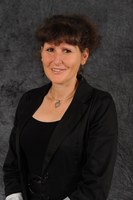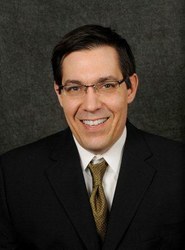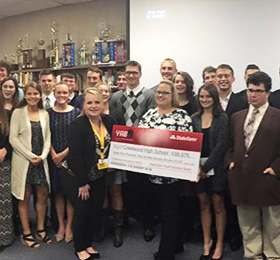
Editor’s Note: In this latest post, we offer a new way of looking at health engagement. A Northeastern Ohio Medical School, NEOMED, is addressing patient-in-community engagement at its root and fostering interest in health professions–by working with youth to self-identify health concerns and design solutions to those problems. The program, the Health Professions Affinity Community or HPAC, is a movement that ripples through a community and ultimately impacts health by engaging people who live in the community to improve the identified health issue. Read on for a few of the striking examples of HPAC work.
The United States is experiencing a shortage of health care professionals that is expected to grow. The Association of American Medical Colleges (2016) estimates that the US may face a shortage of approximately 95,000 physicians due to an increased demand for health care services paired with an aging physician population. There will be a major shortage of other types of health care professionals as well. Underserved communities will be affected the hardest. There has been a call to action to increase the number of students admitted into medical colleges in recent years, but it takes many years to train a student to become a practicing physician.
Northeast Ohio Medical University (NEOMED) has developed the Health Professions Affinity Community (HPAC) program to reduce the health professions shortage, while addressing the health needs of the community through its youth. The HPAC program has grown from a small pilot program in Cleveland, Ohio to one of the largest pipeline programs in the country, serving approximately 2,000 high school and college students across the state of Ohio.
The HPAC program recognizes and uses the power of youth, community and context. Put in a different way, the program empowers youth to identify health concerns and employ local resources to invent and enact community health programs to address them. Through this work, youth become vital community champions for health. HPAC students learn in a hands-on matter to discover and cultivate modest resources in novel ways to fuel community improvement. This perspective asserts that all communities, rich or poor, have existing resources. Students in the HPAC program are attuned to the diverse cultures of their communities and develop real-world and academic competencies in the practice of serving communities. Students in HPAC today serve 15-20,000 Ohioans through grassroots community health improvement projects.
The aims of the HPAC program are to:
- Increase student interest in pursuing a career in the health professions
- Increase college and career readiness
- Improve health from within communities and with community members
- Gain leadership skills
- Increase community engagement
- Increase self-efficacy
The HPAC program has been designed to meet the needs of each type of community and is not a one size fits all program. The program utilizes the IDEAS model to guide students through the main components of creating an HPAC project. Students in the HPAC program complete the following tasks:
- Identify a public health concern present in their community (e.g., obesity, mental health, and bullying).
- Develop grassroots initiatives to address these concerns with local resources and accounting for barriers within a community.
- Enact an initiative with the community to address the health concern.
- Assess the impact of their program (e.g., evaluation).
- Share their successes with their community and at HPAC events.
Hundreds of HPACS have applied the IDEAS model to create projects serving tens of thousands of community members during the past five years. The HPAC IDEAS model promotes the expression of student voice and urges students to take charge of their development, connecting important life tasks to the students’ health concerns. Students find meaning in these activities, which enhances the non-academic aspects of academic success. Furthermore, the model also casts youth in a role positioned spanning school and work as community health entrepreneurs and prepares them for the academic and career skills leading to 21st century health careers.
Successful Programs Making a Real Impact
Students in the HPAC program typically select health concerns that are deeply personal to them. This provides motivation for the students to accomplish projects that have a major impact on the health of their community. A few examples of how HPAC projects have benefited the community include:
- Students from Crestwood High School located in Mantua, Ohio wrote and received a $100,000 grant from State Farm Insurance to build an Aquaponics greenhouse. Their aim is to infuse high-tech agriculture into their STEM education and provide nutritious food to those in need in their rural community.
- Students at Claymont High school organized a color run and invited over 1,000 members of their community to participate in order to raise awareness of the need for physical exercise. They also created a website and invented an app to encourage local residents to utilize a local walking/running trail.
- LOVE IT, an HPAC group from Cleveland, Ohio, developed a public service announcement on YouTube with more than 4,000 downloads and presented on mental health and suicide prevention to hundreds of students across several local schools.
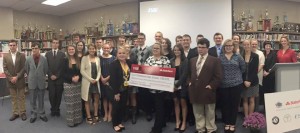
Students from Crestwood High School receiving a check from State Farm that will fund an aquaponics greenhouse to be built on campus.
The HPAC program also offers the opportunity for students to:
- Learn how to write grants to fund their projects. To date, HPAC groups have raised over $400,000 in grant funds to support their projects. NEOMED also has a grant review committee and funding to provide modest financial support student-led projects.
- Academic enrichment like ACT/SAT preparation seminars.
- Receive mentorship from first year medical and pharmacy students at NEOMED.
- Participate in the first student led Project Echo, which serves as a web-enabled think tank between high school, college, and medical students to assess community health needs through various case presentations.
- Present their work at national academic conferences like the annual Family Medicine Education Consortium conference.
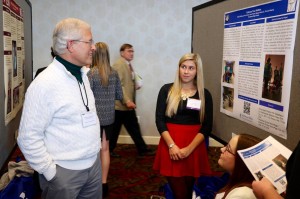
Figure Two: Students from Southeast High School presenting at a poster session at the 2016 Family Medical Education Consortium in Pittsburgh.
The HPAC program repositions health care in the community and recasts students as agents of community health improvement. As opposed to the typical show-and-tell approach that involves bringing students for university and hospital tours, HPAC positions community service in students’ communities and empowers them to take a hands-on approach to their career development.
- There are currently 139 HPAC sites across the state of Ohio during the 2016-2017 academic year
- HPACs exist in both rural and urban communities including, but not limited to, Cleveland, Toledo, Marietta, Cincinnati, Akron and Dayton!
- More than 2,000 students (and growing!) are participating in HPAC currently
If you’d like to learn more about the HPAC program please visit the official HPAC website or follow us on Facebook and Instagram (@hpac.us). Furthermore, you are more than welcome to reach out to either of us, creators of the HPAC program.

